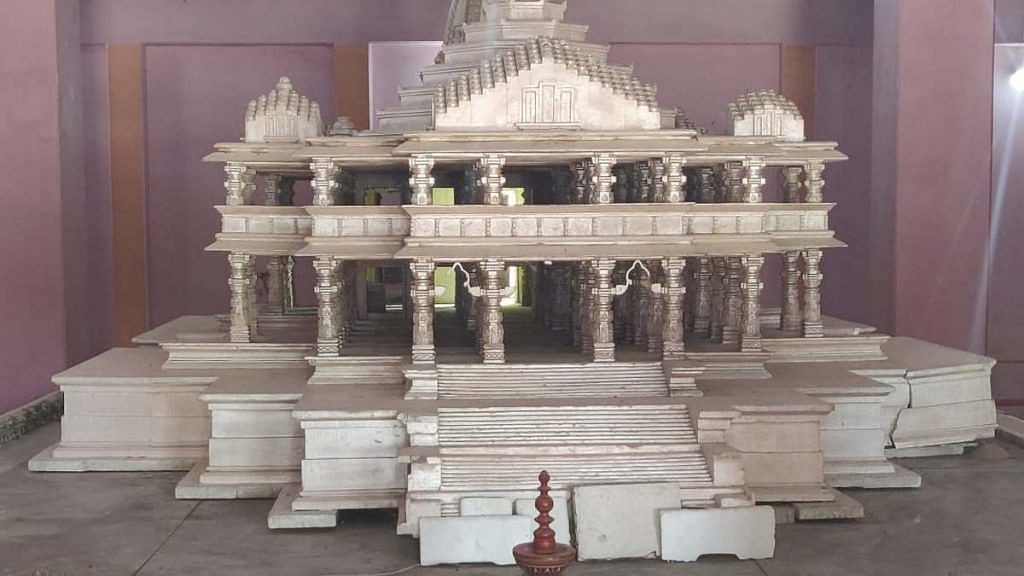Ayodhya: The Supreme Court may have pronounced its judgment allowing construction of the Ram Temple in Ayodhya just Saturday, but a team of artisans, labourers and architects have been working on designing its structure for over 30 years now.
At a workshop in Karsewakpuram — supervised by the Vishwa Hindu Parishad (VHP) — hundreds of boulders in red sandstone with intricate carvings along with designed wooden panels that have fine detailing and ‘Jai Shree Ram’ embossed on each brick, have been readied. All waiting to be shifted to the site.
To do the carvings, workers have been specially called in from Gujarat, Rajasthan and Mirzapur, and the red sandstone has been imported from Bharatpur in Rajasthan.
A model of how the Ram Mandir will look like has also been placed at the entry point of the workshop, where over 200 labourers work for nine hours every day to complete the construction of the temple.
C.B. Sompura, the grandson of the architect who had constructed the famous Somnath temple in Gujarat and also played a significant role in the construction of the Akhshardham temple in Delhi, is supervising this project.
75% per cent work completed
Birju Yadav was 8-years-old when he joined the workshop. Today, he supervises the construction of the temple — right from stocking up the raw materials to monitoring the workers carving the stones.
The verdict, he said, was something that was ‘expected’, which is why they had been working on Ram Mandir’s structure everyday for the last 30 years.
“One boulder takes around two to three months to finish as the detailed carving being done on it takes a lot of time. The work has been on for the past 30 years and 75 per cent of it has already been completed,” he said.
Giving out more details about the construction, Yadav said that out of the two levels — the first has been completed, while work on the second level has begun.
“All the pillars that the ‘bhavya’ mandir will rest on are ready. The construction of the inner courtyard is also being completed. The wall, ceiling and the pillars inside, too, are ready. It will be a temple so grand, that people from across the world will come to see,” he said.
“At the Kumbh Mela this year, we had also put on display the model of the temple, which was approved by all the sadhus, sants and Hindus who had come to pray,” he added.
Speaking on the funds utilised for the temple until now, Yadav said the VHP mostly depends on donations.
“Until now, hundreds of crores (of rupees) have been spent on the construction of this temple, and several hundred more will be spent. However, it is all donation money. People have been very generous and we hope that they will keep donating for the formation of this grand temple,” he said.
Also read: Ram homecoming on loudspeakers, kheer & jalebi: How Ayodhya celebrated SC verdict
Gaushala to be part of temple complex
The temple, which will have 424 carved pillars each measuring 16 feet, carved ceilings and a special throne for Ram Lalla, will also have a special area called the ‘Ram Katha Kunj’ — showcasing the entire life story of lord Ram from his birth.
“We have planned to construct an area that will have Ram’s life story. In that, we will visually depict how Ayodhya used to be when Ram was born putting elements like rivers, birds, forests, etc. It will also have one section that will show the period when Ram went for vanvas (exile). It will have the rivers he went to, where he ate, stayed, and also a visual description of his homecoming. It will be something that no one would have seen before,” Yadav said.
According to the VHP plan, the temple complex will also have a Sita Rasoi, dharamshala, a separate compound for singing bhajans, a ‘Garb Griha’, a specially-designed throne for Ram, a ‘Singh Dwar’ with carvings of lions and elephants at the entry gate, and a rangmandap for cultural activities.
“There will also be a gaushala (cowshed) and a school in the complex where children will be taught about the Vedas,” he said.
The concern
What now concerns the VHP workers is whether the Trust to be appointed by the central government to construct the temple will acknowledge their hard work.
They, however, said they trust their leaders. “We have been doing our job for years because we were certain that the Ram Temple will be built if not today, then tomorrow. Now, the time has come and even if a Trust has been set up, we are certain that the design that we have been working on for the last 30 years will be taken,” Ved Lal, another worker, said.
“We trust our leaders. We have been at the forefront of this fight from the beginning and are certain that we will be rewarded,” he added.
Also read: What happens to Babri criminal trial against Advani, others after SC condemns demolition
